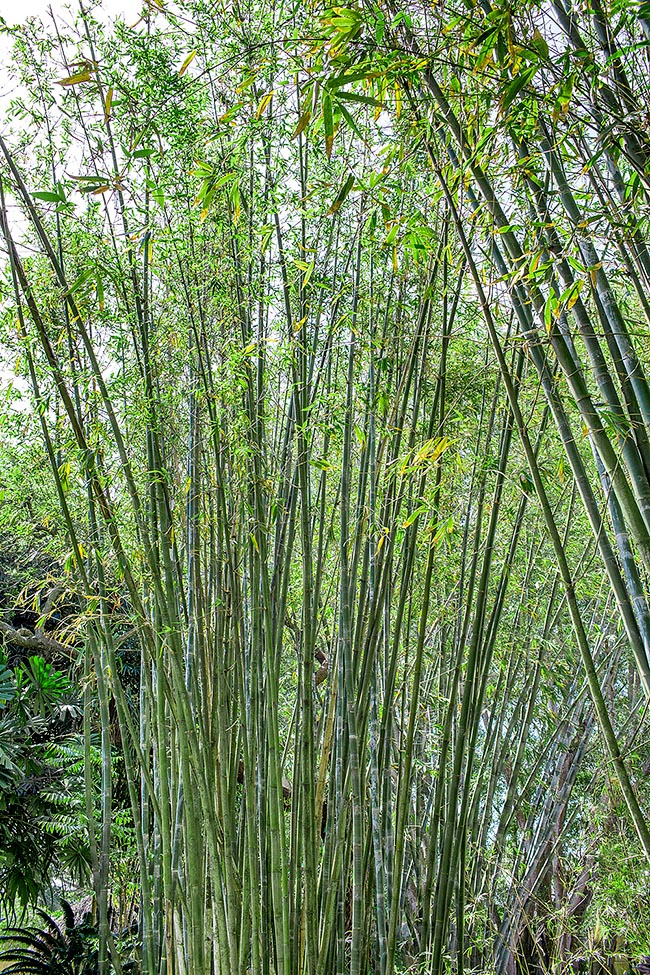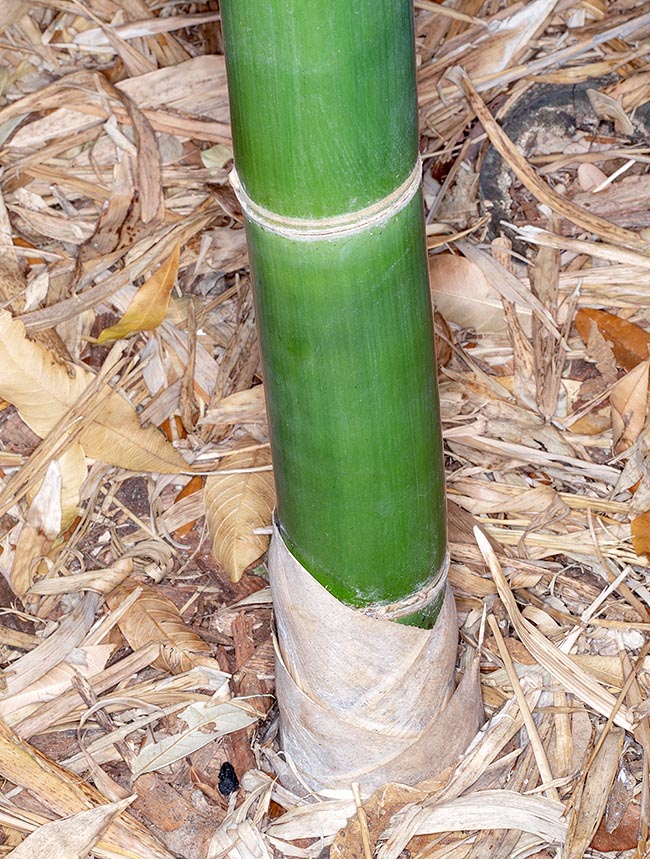Family : Poaceae

Text © Pietro Puccio

English translation by Mario Beltramini

Native to China and Taiwan, Bambusa oldhamii reaches the 6-18 m of height with dense tufts and erect stems, only slightly curved at apex. It is among the most decorative bamboos. Good resistance to cold and limited invasiveness © Giuseppe Mazza
The species is native to China (Fujian, Guangdong, Guangxi, Hainan and Zhejiang) and Taiwan where it grows in the humid forests at low altitudes.
The name of the genus comes from the local Malay name “bambu”; the species is honoured to the English collector Richard Oldham (1837-1864) who discovered it and collected its samples in Taiwan.
Common names: giant timber bamboo, green bamboo, Oldham’s bamboo (English); lü zhu (Chinese); ryoku-chiku (Japanese).
The Bambusa oldhamii Munro (1868) is an evergreen rhizomatous perennial species, that forms dense tufts with stems (culms) erect, just slightly curved at the apex, 6-18 m tall and of 6-12 cm of diameter at the base, with 18-30 cm long internodes, initially glaucous, then olive green, glabrous; the culms are hollow between the nodes with walls of about 1 cm of thickness.
When young the culms are protected by foliar sheaths lanceolate, 10-30 cm long, initially covered by irritant brown hairs that fall when the sheath dries; deciduous leaves almost triangular with acuminate apex.
Numerous ramifications grouped at the nodes, but the lowest ones, that rarely exceed the length of 1 m, with a branch of diameter bigger than the others, and alternate oblong-lanceolate leaves with acuminate apex, 8-25 cm long and 2-6 m broad, pubescent below. About 1 m long inflorescences with sessile spikelets laterally flattened grouped at the nodes, 3-4 cm long, and 5-9 flowers.
It reproduces by seed, put superficially in draining soil maintained constantly humid at the temperature of 22-24 °C, with variable germination times, up to some months, by division, with a minimum of three culms, and micro propagation.
Among the tallest and decorative bamboos, of limited invasiveness, averagely fast growth, good resistance to the low temperatures, up to -6 °C if exceptional and short lasting, and to the salty winds, ideal for creating in few years shielding hedges, windbreak and antinoise barriers.

Culms of 6-12 cm of diameter at the base. Edible shoots after cooking, rich of vitamins, minerals and fibres © Giuseppe Mazza
It grows at the best in the tropical and subtropical humid regions and in those with warm temperate climate with high summer temperatures and particularly mild winters, in less favourable conditions the speed of growth and the height decrease. It needs full sun and is not particular about the soil, provided draining and with ample availability of water, in particular in the climates with long warm and dry summers.
Its shoots, deprived of the outer layers, are edible after cooking, very much appreciated in Taiwan, where the species is widely cultivated for this purpose, poor of calories and rich of vitamins, in particular A, B1, B2 and C, mineral and fibres.
The shoots are poisonous if consumed raw, as they contain a cyanogenetic glycoside, the taxiphyllin, with sour taste, that transforms in hydrocyanic acid, but that luckily is thermolabile and is in good part neutralized after boiling for about 40 minutes.
Synonyms: Arundarbor oldhamii (Munro) Kuntze (1891); Leleba oldhamii (Munro) Nakai (1933); Sinocalamus oldhamii (Munro) McClure (1940); Dendrocalamopsis oldhamii (Munro) Keng f. (1983); Bambusa atrovirens T.H.Wen (1986); Bambusa oldhamii f. revoluta W.T.Lin & J.Y.Lin (1988); Dendrocalamopsis atrovirens (T.H.Wen) Keng f. ex W.T.Lin (1990); Neosinocalamus revolutus (W.T.Lin & J.Y.Lin) T.H.Wen (1991); Sinocalamus oldhamii f. revolutus (W.T.Lin & J.Y.Lin) W.T.Lin (1993); Bambusa revoluta (W.T.Lin & J.Y.Lin) N.H.Xia, R.H.Wang & R.S.Lin (2009).
→ To appreciate the biodiversity within the POACEAE family please click here.
